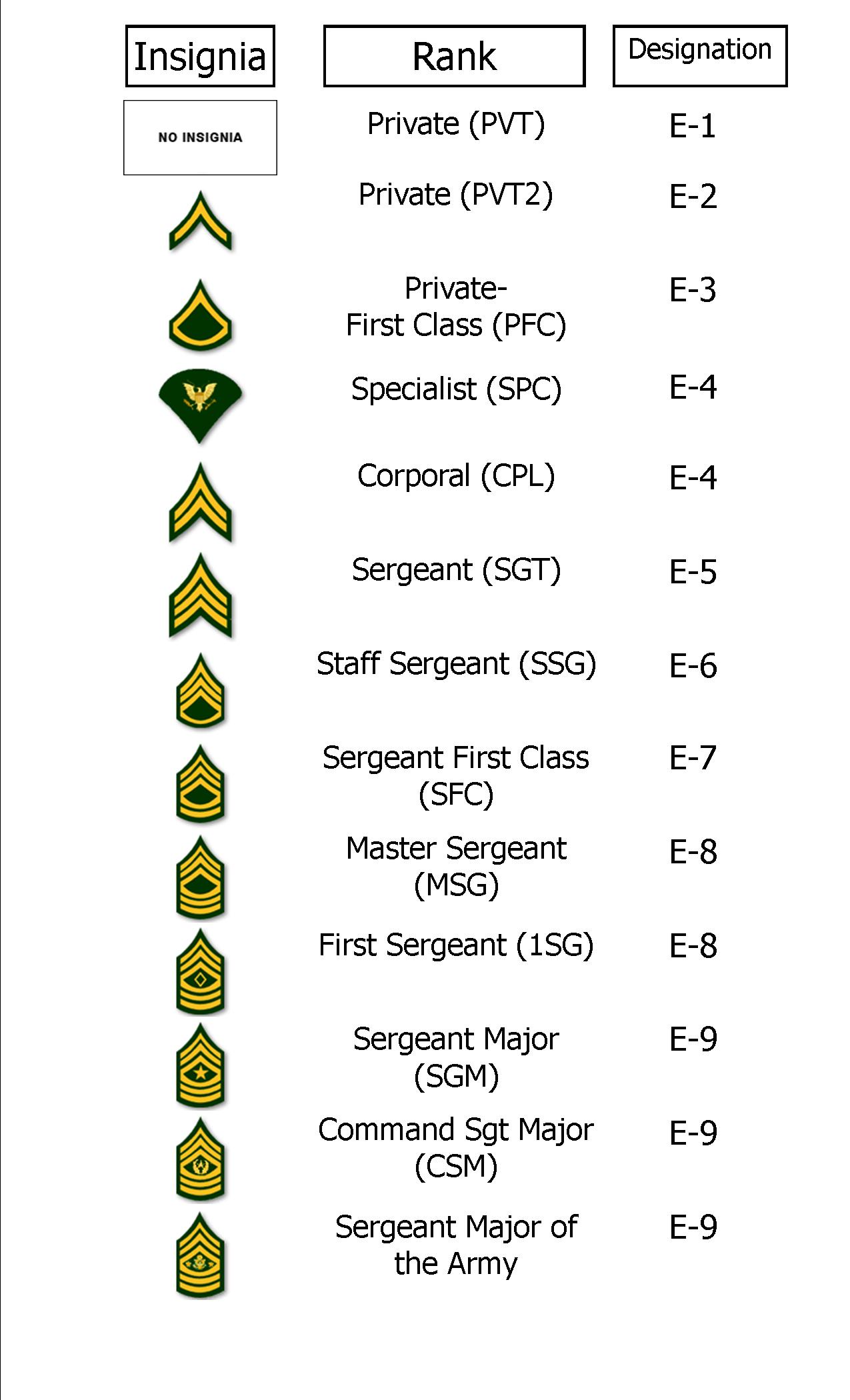

Must graduate the primary leadership development course (PLDC).The competition is based on a point system that grants points for firing range scores, performance evaluations, physical fitness, education level, awards and promotion board ranking.Ĭorporals and specialists must meet the following basic eligibility criteria to compete: Moving up the Army ranks: Unlike the promotion processes for privates, specialists and corporals, promotions to sergeant (SGT) and staff sergeant (SSG) is based on an Army-wide competition.
#Enlisted ranks professional#
While certainly the new sergeant will be developing new skills, strengthening old ones and generally getting better, he is a sergeant and is therefore no less a professional than those grades of rank to follow.
#Enlisted ranks how to#
The rank of sergeant is not a position for learning how to become a leader no apprenticeship here. Professionally competent leaders inherently command respect for their authority, and the sergeant must be unquestionably competent in order to carry out the mission correctly, accomplish each task and care for assigned soldiers. The authority of the sergeant is equal to that of any other grade or rank of the NCO. Their unit is trained to function in its primary mission role.While on duty status, they are ready at all times to report to the location and activity of all members of their unit.All government property issued to members of their unit is maintained properly and accounted for at all times, and discrepancies are reported promptly.Each member of their unit is trained to competency in their MOS, as prescribed in the appropriate soldiers manual.The sergeant also is responsible for insuring that: Like the next grade, the staff sergeant, the sergeant is responsible for the individual training, personal appearance and the cleanliness of their soldiers. It is the grade sergeant that the privates will look to for example. Privates, who are the basic manpower strength and grade of the Army, generally have sergeants as their first NCO leader. Although not the lowest level of rank where command is exercised, this level is the first at which enlisted soldiers are referred to as sergeant, and of all the grades of the NCO, this one, very possibly, has the greatest impact on the lower ranking-soldiers. Sergeants (SGT) operate in an environment where the sparks fly - where the axe meets the stone. Like the junior enlisted ranks, commanders may advance soldiers on an accelerated basis. Security clearance appropriate for the MOS in which promoted advancement may be based on granting an interim security clearance.Six months' time in grade, waiver-able to three months.Moving up the Army ranks: Normally, unit commanders may advance PFCs to corporal once they have met the following qualifications: As the NCO Corps is known as the backbone of the Army, the corporal is the backbone of the NCO Corps.

Like the grade of sergeant, corporals are responsible for individual training, personal appearance and cleanliness of their soldiers.Īs the command sergeant major is known as the epitome of success in the NCO Corps, the corporal is the beginning of the NCO Corps. For the most part, corporals have served as the smallest unit leaders in the Army: principally, leaders of teams. The rank of corporal always has been placed at the base of the NCO ranks. Along with the rank of sergeant, the corporal is the only rank that never has disappeared from the NCO Corps. The highest of the enlisted ranks is the Sergeant Major of the Army: there is only one person in the entire Army, including the National Guard, that can hold this rank and he is senior adviser to the Chief of Staff of the Army.The rank of corporal was established in 1775 with the birth of the Army and the NCO Corps. A Command Sergeant Major advises commander and staff, assists in training and assists officers commanding up to 5,000 soldiers. A Sergeant Major assists officers in command of up to 1,000 soldiers. A First Sergeant disciplines, counsels and instructs lower ranks and other Sergeants while helping to train enlisted soldiers. A Sergeant First class assists the platoon leader and usually has around 15 years of experience and a Master Sergeant takes on a more administrative role and dispatches duties among the lower ranks. There are quite a few ranks with the term “sergeant” in them: a Sergeant can oversee the daily tasks of a squad of 10 soldiers, while a Staff Sergeant commands a squad and leads one or two Sergeants. A Specialist is the next rank up, has served at least two years and manages some soldiers of lower ranks. Second grade Privates are promoted to Private First Class after one year of service with the National Guard. This rank is generally given to trainees who have begun basic training. There are two grades of “Private,” both with the same general duty. Private ranks are the lowest of the enlisted ranks.


 0 kommentar(er)
0 kommentar(er)
